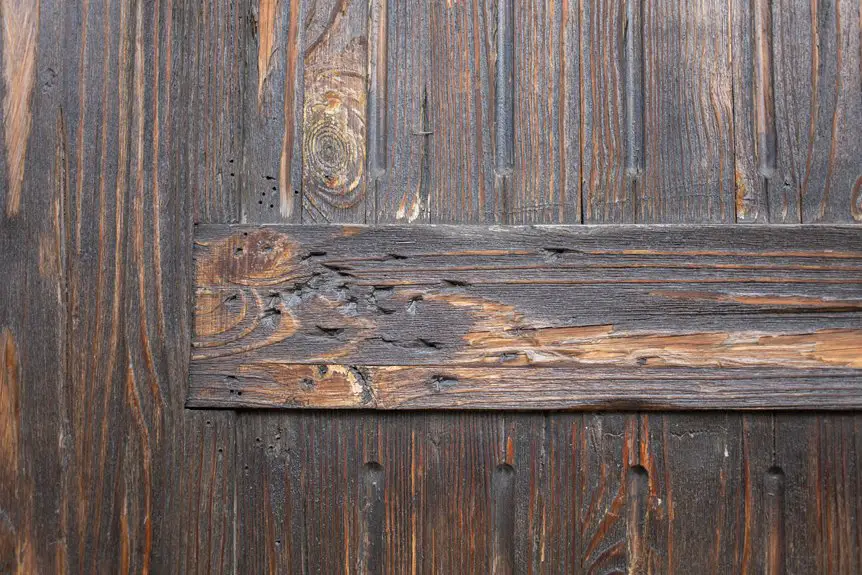To mount your DIY sound panels without damaging the wall, use adhesive hooks or strips designed for lightweight panels. For heavier options, consider picture hanging strips that provide a clean look while ensuring stability. Velcro strips also offer strong attachment and allow easy repositioning. Make sure to clean the surfaces before applying any adhesive. If you’re curious about the best arrangement and maintenance tips for your sound panels, there’s more useful information ahead.
Table of Contents
Key Takeaways
- Use Command Hooks for easy, damage-free mounting; they can be removed without leaving marks on the wall.
- Opt for Velcro strips for a secure attachment that allows for easy adjustment and removal of sound panels.
- Clean the wall and panel backs prior to applying adhesive strips for optimal bonding.
- Choose adhesive options that support the weight of your panels; check weight limits for safety.
- Experiment with panel arrangements to find the best sound absorption while keeping the installation damage-free.
Understanding Sound Panel Materials
When diving into DIY sound panels, knowing the right materials is essential for achieving ideal acoustic performance.
You’ll want to evaluate options like mineral wool or acoustic foam, both of which effectively absorb sound. Mineral wool is dense and excellent for high-frequency sounds, while acoustic foam is lightweight and easy to shape.
Evaluate materials like mineral wool and acoustic foam for effective sound absorption; each offers unique benefits for your DIY panels.
You might also opt for plywood or fabric to create the frame and cover your panels, ensuring both durability and aesthetics. Make sure the fabric you choose is breathable to allow sound absorption.
Remember, the thickness of your panels matters; thicker panels usually yield better results.
Choosing the Right Mounting Method
After selecting the right materials for your DIY sound panels, the next step involves choosing an effective mounting method. You’ve got several options to evaluate based on your wall type and panel weight.
If you’re working with lightweight panels, adhesive hooks or strips can be a great choice, as they minimize damage. For heavier panels, think about using picture frame hangers or wall brackets, which provide better support.
Always check the weight limits of your chosen hardware to verify safety. It’s also wise to reflect on the layout of your sound panels—arranging them for maximum acoustic benefit can elevate your space’s sound quality.
Once you’ve decided on the method, you’ll be ready to secure those panels confidently and effectively.
Using Adhesive Strips for Easy Installation
When it comes to mounting your sound panels, adhesive strips can make the process quick and hassle-free.
You’ll want to choose the right strips for your wall type and panel weight, so they hold securely.
Plus, applying them correctly can save you time and guarantee a clean installation.
Choosing the Right Strips
Choosing the right adhesive strips can make your DIY sound panel installation a breeze, as they offer a no-fuss solution for securing panels to your walls. When selecting strips, consider the weight of your panels and the surface type. Look for strips that provide strong adhesion and easy removal without leaving residue.
Here’s a quick comparison of popular adhesive strips:
| Strip Type | Weight Capacity |
|---|---|
| Command Strips | Up to 5 lbs |
| Velcro Strips | Up to 10 lbs |
| Double-Sided Tape | Up to 15 lbs |
| Foam Mounting Tape | Up to 20 lbs |
| Heavy-Duty Strips | 20 lbs and more |
Pick the right strips for your project, ensuring a secure and damage-free installation!
Application Tips and Tricks
To guarantee a smooth installation of your DIY sound panels, it’s essential to prep both the surface and the strips properly. Start by cleaning the wall with rubbing alcohol to remove dust and oils, ensuring a strong bond.
Next, cut the adhesive strips to the appropriate length, following the manufacturer’s guidelines. When applying the strips, press firmly for at least 30 seconds to activate the adhesive.
It’s best to attach the strips to the back of the panel first, then align and press the panel against the wall. For added support, consider using multiple strips on larger panels.
Finally, give everything 24 hours to set before adjusting or moving the panels, ensuring they stay in place without damage.
Command Hooks: A Removable Solution
If you’re looking for a simple way to hang your sound panels, Command Hooks are a great option.
They offer an easy installation process, but you’ll want to keep weight limits and surface compatibility in mind.
Let’s explore how to make the most of this removable solution for your DIY project.
Easy Installation Process
While you might think that mounting sound panels requires a complex setup, using command hooks offers a simple and effective solution. These hooks allow you to hang your panels without damaging the wall. Here’s a quick comparison of the benefits:
| Feature | Description |
|---|---|
| Easy Installation | Just peel, stick, and hang. |
| No Tools Required | No drills or nails needed. |
| Removable | Can be taken down without marks. |
| Versatile | Works on various surfaces. |
| Cost-Effective | Affordable and reusable. |
With command hooks, you’ll have your sound panels up in no time. Just remember to follow the instructions for the best results, and enjoy your improved audio experience!
Weight Limit Considerations
When choosing command hooks for your sound panels, it’s important to take into account their weight limits, as exceeding these can lead to unwanted falls.
Each hook has a specified weight capacity, so you’ll want to weigh your panels before selecting the right hooks. If your panels are heavier than the recommended limit, consider using multiple hooks to distribute the weight evenly.
It’s better to err on the side of caution; using hooks rated for higher weights guarantees your panels stay securely mounted. Always double-check the packaging for specific weight guidelines, and don’t hesitate to opt for stronger solutions like wall anchors if your panels exceed command hooks’ limits.
This way, you’ll protect your walls and your sound panels.
Surface Compatibility Tips
Choosing the right surface for your command hooks is essential for ensuring your sound panels stay put. Smooth, clean surfaces like painted drywall or metal work best, as they allow for maximum adhesion.
Avoid textured or porous materials like brick or unpainted wood, which can compromise the hook’s hold. Before applying the hooks, clean the surface with rubbing alcohol to remove dust and oils; this helps them stick better.
If you’re dealing with a glossy finish, consider using a primer or adhesive designed for such surfaces. Remember, the weight of your sound panels matters too—make sure your command hooks can handle their weight.
With the right surface, you’ll enjoy a damage-free and effective sound panel installation.
Velcro Strips for Secure Yet Gentle Attachment
Velcro strips offer a practical solution for attaching your DIY sound panels securely yet gently. They allow you to easily remove or reposition the panels without damaging your walls. To get started, choose high-quality Velcro strips with a strong adhesive backing.
| Step | Description |
|---|---|
| Preparation | Clean the wall surface and the panel back. |
| Application | Stick one side of the Velcro to the panel, the other to the wall. |
| Press & Hold | Firmly press for a few seconds to guarantee a strong bond. |
Using Velcro strips not only provides a reliable attachment but also gives you flexibility in adjusting your sound panels as needed. Enjoy your enhanced sound environment without the worry of wall damage!
Picture Hanging Strips for a Seamless Look
Picture hanging strips provide an elegant solution for mounting your DIY sound panels with a seamless look.
These strips are designed to hold securely without leaving any marks or damage to your walls. You simply attach one side of the strip to the back of your sound panel and the other side to the wall.
Designed for secure holding, these strips won’t damage your walls—just attach and remove with ease.
When you’re ready to remove or reposition the panels, it’s as easy as pulling the tab to release them without any hassle.
Plus, the strips come in various sizes, so you can choose the strength that fits your panel’s weight.
This method not only keeps your panels looking sleek, but it also allows for a clean, professional appearance in your space.
Tips for Arranging Your Sound Panels Effectively
While you might be keen to hang your sound panels, arranging them effectively can make a significant difference in their performance. Start by identifying the most reflective surfaces in your room, like windows or hard walls. Position your panels strategically on these areas to absorb sound waves.
A common arrangement is to create a pattern or grid, allowing for an even distribution. Don’t forget to take into account height—placing panels at ear level can maximize their effectiveness. Experiment with different layouts; move them around and listen to the changes in sound quality.
Finally, keep in mind the aesthetics—choose colors and designs that complement your space, ensuring your sound panels not only improve acoustics but also enhance your room’s look.
Frequently Asked Questions
Can I Reuse Adhesive Strips on Different Walls?
You can’t reliably reuse adhesive strips on different walls. They lose their stickiness after removal, making them less effective. It’s best to use new strips to guarantee a secure hold and prevent damage.
What Weight Limits Do Adhesive Strips Have?
Adhesive strips typically support weights ranging from one to three pounds per strip. For heavier items, you’ll need multiple strips or consider alternatives. Always check the packaging for specific weight limits before mounting anything.
Will Mounting Hardware Leave Marks on Painted Walls?
You might wonder if mounting hardware will leave marks on your painted walls. Well, it depends on the type you use. Some can damage the paint, while others won’t—choose wisely to avoid a mess!
Can Sound Panels Be Mounted on Textured Walls?
Yes, you can mount sound panels on textured walls. Just make certain you use appropriate adhesive or mounting hardware designed for uneven surfaces. This’ll help secure the panels effectively while maintaining their aesthetic appeal.
How Do I Remove Sound Panels Without Damage?
To remove sound panels without damage, gently slide a putty knife between the panel and wall. Carefully lift and pull the panel away. If adhesive remains, use a soft cloth and mild adhesive remover to clean the surface.




